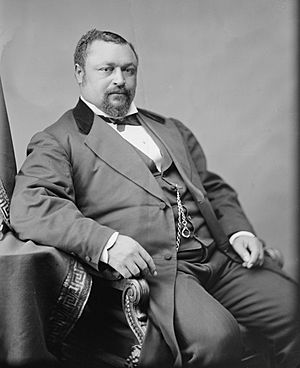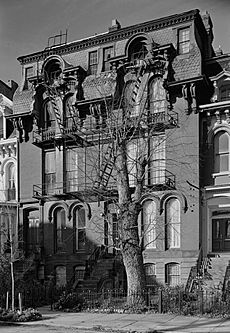Blanche Bruce facts for kids
Quick facts for kids
Blanche Bruce
|
|
|---|---|
 |
|
| Register of the Treasury | |
| In office December 3, 1897 – March 17, 1898 |
|
| President | William McKinley |
| Preceded by | Fount Tillman |
| Succeeded by | Judson Lyons |
| In office May 21, 1881 – June 5, 1885 |
|
| President | James A. Garfield Chester A. Arthur Grover Cleveland |
| Preceded by | Glenni Scofield |
| Succeeded by | William Rosecrans |
| United States Senator from Mississippi |
|
| In office March 4, 1875 – March 4, 1881 |
|
| Preceded by | Henry R. Pease |
| Succeeded by | James Z. George |
| Personal details | |
| Born |
Blanche Kelso Bruce
March 1, 1841 Farmville, Virginia, U.S. |
| Died | March 17, 1898 (aged 57) Washington, D.C., U.S. |
| Resting place | Woodlawn Cemetery |
| Political party | Republican |
| Spouse | Josephine Willson |
| Children | Roscoe |
| Education | Oberlin College |
| Signature | |
Blanche Kelso Bruce (March 1, 1841 – March 17, 1898) was an important American politician. He was born into slavery in Virginia. Later, he became a Republican United States Senator for Mississippi.
He served in the Senate from 1875 to 1881. Bruce was the first elected African-American senator to complete a full term. Another African American, Hiram Rhodes Revels, also from Mississippi, served before him but for a shorter time.
Contents
Blanche Bruce's Early Life and Education

Blanche Bruce was born in 1841 in Prince Edward County, Virginia. His mother, Polly Bruce, was an African-American woman who was enslaved. His father, Pettis Perkinson, was a white Virginia planter (a large farm owner).
Bruce was treated better than many enslaved people. His father made sure he received an education. He studied alongside his white half-brother. Some sources say his father freed him legally. However, Bruce himself stated he gained freedom by moving to Kansas when the American Civil War began.
After gaining his freedom, Bruce taught at a school. He also attended Oberlin College in Oberlin, Ohio for two years. Later, he worked on a steamboat on the Mississippi River. In 1864, he moved to Hannibal, Missouri, where he started a school for black children.
Bruce's Political Career
In 1868, during the Reconstruction period after the Civil War, Bruce moved to Bolivar, Mississippi. He bought a large farm there and became a successful landowner. He owned thousands of acres in the Mississippi Delta.
Bruce quickly became involved in local government. He was appointed as a voter registrar and tax assessor for Tallahatchie County. Then, he was elected sheriff in Bolivar County. He also served as a tax collector and supervisor of education. He even worked as an editor for a local newspaper. In 1870, he became the sergeant-at-arms for the Mississippi State Senate.
Serving in the U.S. Senate
In February 1874, Blanche Bruce was elected to the United States Senate. He was the second African American to serve in the Senate. On February 14, 1879, Bruce made history again. He became the first African American to preside over the U.S. Senate. This meant he led the Senate's meetings for a time.
After his Senate term ended in 1881, James Z. George took his place. George was a former Confederate Army soldier and a Democrat.
Later Government Roles
At the 1880 Republican National Convention in Chicago, Bruce received eight votes for Vice President. This made him the first African American to receive votes for a national office at a major political party's convention.
Bruce continued to serve the public. From 1890 to 1893, he was the District of Columbia recorder of deeds. This job involved keeping official records. He also served on the District of Columbia Board of Trustees of Public Schools from 1892 to 1895. In 1897, President William McKinley appointed him as Register of the Treasury for a second time. He held this position until he passed away in 1898 from complications of diabetes.
Blanche Bruce's Personal Life
On June 24, 1878, Blanche Bruce married Josephine Beall Willson. She was a well-known socialite from Cleveland, Ohio. Their wedding was a big event, and they traveled to Europe for their honeymoon.
Their only child, Roscoe Conkling Bruce, was born in 1879. He was named after U.S. Senator Roscoe Conkling of New York. Senator Conkling was a mentor to Blanche Bruce in the Senate.
Blanche Bruce was proud of his heritage. He often said, "I am a Negro and proud of it." He lived in Washington, D.C., after his Senate term. He bought a large house and a summer home. He was an important figure in the African-American community there.
Honors and Legacy
Blanche Bruce's home in the Shaw neighborhood of Washington, D.C., was recognized as a National Historic Landmark in 1975. This means it's a place of special historical importance.
In 1999, the U.S. Senate decided to have a portrait painted of Bruce. Simmie Knox, an African-American artist from Washington, D.C., painted it. The portrait was revealed in the Capitol building in 2001.
A special historical marker was placed near Bruce's birthplace in Virginia in 2006. This marker helps people remember where he was born.
Bruce School
In July 1898, a new public school in Washington, D.C., was named the Bruce School in his honor. This school later became Caesar Chavez Prep Middle School. In 1973, the Bruce School and James Monroe school combined to form the integrated Bruce-Monroe school.
See also


